Snow Lapse Rate Changes in the Atlas Mountain in Morocco Based on MODIS Time Series during the Period 2000–2016
Abstract
:1. Introduction
2. Study Site
3. Data and Methods
3.1. MODIS Daily Fractional Snow Product (MOD10A1)
3.2. Extraction of Snow Cover Metrics
3.3. Topographic Effects
4. Results and Discussion
4.1. Spatial and Temporal Variation of Snow Cover
4.2. Global Altitudinal Effect on Snow Cover Metrics
4.3. Snow Cover Metrics in Relation to Aspect
4.4. Snow Cover Metrics in Relation to Slope
4.5. Snow Metrics Lapse Rate Change
5. Conclusions
- The snow cover is mainly affected by elevation, inducing a remarkable snow lapse rate. The quantity and timing (onset and melt-out dates and duration) of snow cover share the same pattern in their vertical distribution across the Atlas Mountains.
- The altitudinal gradient of the SCD shows a decreasing trend. Since 2007, the SCD gradient in the Atlas Mountains has decreased from 6 days/100 m to 3 days/100 m. However, the change in the altitudinal gradient of SOSS is marked by a positive trend.
- The altitudinal gradient of EOSS presents a potential contrasting response to climate change, with an increasing trend for elevations below 2500 m and a decreasing trend for altitudes between 2500 and 4000 m. The controls of orientation on snow cover metrics are not clear enough at the Atlas scale and even by basin, which can be related to the coarse spatial resolution of MODIS images that do not take into account the aspect control. The snowpack homogeneity can be considered as an important factor for spatial snow distribution associated with other topographic features. Both SCA and SCD increase with the slope. This can be explained by the fact that a significant part of the steep slopes is located at high altitudes, and steeper slopes receive less radiation than flatter surfaces.
Author Contributions
Funding
Data Availability Statement
Conflicts of Interest
References
- Hall, D.K.; Riggs, G.A. Accuracy assessment of the MODIS snow products. Hydrol. Process. 2007, 21, 1534–1547. [Google Scholar] [CrossRef]
- Chehbouni, A.; Escadafal, R.; Duchemin, B.; Boulet, G.; Simonneaux, V.; Dedieu, G.; Mougenot, B.; Khabba, S.; Kharrou, H.; Maisongrande, P.; et al. An integrated modelling and remote sensing approach for hydrological study in arid and semi-arid regions: The SUDMED Programme. Int. J. Remote Sens. 2008, 29, 5161–5181. [Google Scholar] [CrossRef] [Green Version]
- Jarlan, L.; Khabba, S.; Er-Raki, S.; Le Page, M.; Hanich, L.; Fakir, Y.; Merlin, O.; Mangiarotti, S.; Gascoin, S.; Ezzahar, J.; et al. Remote Sensing of Water Resources in Semi-Arid Mediterranean Areas: The joint international laboratory TREMA. Int. J. Remote Sens. 2015, 36, 4879–4917. [Google Scholar] [CrossRef]
- Saydi, M.; Ding, J.-L.; Sagan, V.; Qin, Y. Snowmelt modeling using two melt-rate models in the Urumqi River watershed, Xinjiang Uyghur Autonomous Region, China. J. Mt. Sci. 2019, 16, 2271–2284. [Google Scholar] [CrossRef]
- Boudhar, A.; Hanich, L.; Boulet, G.; Duchemin, B.; Berjamy, B.; Chehbouni, A. Evaluation of the Snowmelt Runoff Model in the Moroccan High Atlas Mountains using two snow-cover estimates. Hydrol. Sci. J. 2009, 54, 1094–1113. [Google Scholar] [CrossRef]
- Marchane, A.; Jarlan, L.; Hanich, L.; Boudhar, A.; Gascoin, S.; Tavernier, A.; Filali, N.; Le Page, M.; Hagolle, O.; Berjamy, B. Assessment of daily MODIS snow cover products to monitor snow cover dynamics over the Moroccan Atlas mountain range. Remote Sens. Environ. 2015, 160, 72–86. [Google Scholar] [CrossRef]
- Chaponnière, A.; Maisongrande, P.; Duchemin, B.; Hanich, L.; Boulet, G.; Escadafal, R.; Elouaddat, S. A combined high and low spatial resolution approach for mapping snow covered areas in the Atlas Mountains. Int. J. Remote Sens. 2005, 26, 2755–2777. [Google Scholar] [CrossRef] [Green Version]
- Choi, G.; Robinson, D.A.; Kang, S. Changing Northern Hemisphere Snow Seasons. J. Clim. 2010, 23, 5305–5310. [Google Scholar] [CrossRef]
- Peng, S.; Piao, S.; Ciais, P.; Friedlingstein, P.; Zhou, L.; Wang, T. Change in snow phenology and its potential feedback to temperature in the Northern Hemisphere over the last three decades. Environ. Res. Lett. 2013, 8, 014008. [Google Scholar] [CrossRef] [Green Version]
- Boudhar, A.; Duchemin, B.; Hanich, L.; Boulet, G.; Chehbouni, A. Spatial distribution of the air temperature in mountainous areas using satellite thermal infra-red data. Comptes Rendus Geosci. 2011, 343, 32–42. [Google Scholar] [CrossRef] [Green Version]
- Schulz, O.; De Jong, C. Snowmelt and sublimation: Field experiments and modelling in the High Atlas Mountains of Morocco. Hydrol. Earth Syst. Sci. 2004, 8, 1076–1089. [Google Scholar] [CrossRef] [Green Version]
- Frei, A.; Tedesco, M.; Lee, S.; Foster, J.; Hall, D.K.; Kelly, R.; Robinson, D.A. A review of global satellite-derived snow products. Adv. Space Res. 2012, 50, 1007–1029. [Google Scholar] [CrossRef] [Green Version]
- Calleja, J.F.; Corbea-Pérez, A.; Fernández, S.; Recondo, C.; Peón, J.; de Pablo, M.Á. Snow Albedo Seasonality and Trend from MODIS Sensor and Ground Data at Johnsons Glacier, Livingston Island, Maritime Antarctica. Sensors 2019, 19, 3569. [Google Scholar] [CrossRef] [PubMed] [Green Version]
- Brown, R.D.; Mote, P.W. The Response of Northern Hemisphere Snow Cover to a Changing Climate. J. Clim. 2009, 22, 2124–2145. [Google Scholar] [CrossRef]
- López-Moreno, J.I.; Pomeroy, J.W.; Revuelto, J.; Vicente-Serrano, S.M. Response of snow processes to climate change: Spatial variability in a small basin in the Spanish Pyrenees. Hydrol. Process. 2013, 27, 2637–2650. [Google Scholar] [CrossRef]
- López-Moreno, J.I.; Revuelto, J.; Gilaberte, M.; Morán-Tejeda, E.; Pons, M.; Jover, E.; Esteban, P.; García, C.; Pomeroy, J.W. The effect of slope aspect on the response of snowpack to climate warming in the Pyrenees. Theor. Appl. Clim. 2013, 117, 207–219. [Google Scholar] [CrossRef] [Green Version]
- Lehning, M.; Völksch, I.; Gustafsson, D.; Nguyen, T.A.; Stähli, M.; Zappa, M. ALPINE3D: A detailed model of mountain surface processes and its application to snow hydrology. Hydrol. Process. 2006, 20, 2111–2128. [Google Scholar] [CrossRef]
- Letsinger, S.L.; Olyphant, G.A. Distributed energy-balance modeling of snow-cover evolution and melt in rugged terrain: Tobacco Root Mountains, Montana, USA. J. Hydrol. 2007, 336, 48–60. [Google Scholar] [CrossRef]
- Lopez-Moreno, I.; Stähli, M. Statistical analysis of the snow cover variability in a subalpine watershed: Assessing the role of topography and forest interactions. J. Hydrol. 2008, 348, 379–394. [Google Scholar] [CrossRef]
- Lee, W.-L.; Liou, K.N.; Wang, C.-C. Impact of 3-D topography on surface radiation budget over the Tibetan Plateau. Theor. Appl. Clim. 2012, 113, 95–103. [Google Scholar] [CrossRef]
- Baba, M.W.; Gascoin, S.; Kinnard, C.; Marchane, A.; Hanich, L. Effect of Digital Elevation Model Resolution on the Simulation of the Snow Cover Evolution in the High Atlas. Water Resour. Res. 2019, 55, 5360–5378. [Google Scholar] [CrossRef]
- Tong, J.; Déry, S.J.; Jackson, P.L. Topographic control of snow distribution in an alpine watershed of western Canada inferred from spatially-filtered MODIS snow products. Hydrol. Earth Syst. Sci. 2009, 13, 319–326. [Google Scholar] [CrossRef] [Green Version]
- Baba, M.W.; Gascoin, S.; Jarlan, L.; Simonneaux, V.; Hanich, L. Variations of the Snow Water Equivalent in the Ourika Catchment (Morocco) over 2000–2018 Using Downscaled MERRA-2 Data. Water 2018, 10, 1120. [Google Scholar] [CrossRef] [Green Version]
- Bouamri, H.; Kinnard, C.; Boudhar, A.; Gascoin, S.; Hanich, L.; Chehbouni, A. MODIS Does Not Capture the Spatial Heterogeneity of Snow Cover Induced by Solar Radiation. Front. Earth Sci. 2021, 9, 640250. [Google Scholar] [CrossRef]
- Dietz, A.J.; Conrad, C.; Kuenzer, C.; Gesell, G.; Dech, S. Identifying Changing Snow Cover Characteristics in Central Asia between 1986 and 2014 from Remote Sensing Data. Remote Sens. 2014, 6, 12752–12775. [Google Scholar] [CrossRef] [Green Version]
- Bormann, K.J.; Brown, R.D.; Derksen, C.; Painter, T.H. Estimating snow-cover trends from space. Nat. Clim. Chang. 2018, 8, 924–928. [Google Scholar] [CrossRef]
- Boudhar, A.; Boulet, G.; Hanich, L.; Sicart, J.E.; Chehbouni, A. Energy fluxes and melt rate of a seasonal snow cover in the Moroccan High Atlas. Hydrol. Sci. J. 2016, 61, 931–943. [Google Scholar] [CrossRef]
- Bouamri, H.; Boudhar, A.; Gascoin, S.; Kinnard, C. Performance of temperature and radiation index models for point-scale snow water equivalent (SWE) simulations in the Moroccan High Atlas Mountains. Hydrol. Sci. J. 2018, 63, 1844–1862. [Google Scholar] [CrossRef]
- Baba, M.; Boudhar, A.; Gascoin, S.; Hanich, L.; Marchane, A.; Chehbouni, A. Assessment of MERRA-2 and ERA5 to Model the Snow Water Equivalent in the High Atlas (1981–2019). Water 2021, 13, 890. [Google Scholar] [CrossRef]
- Boudhar, A.; Duchemin, B.; Hanich, L.; Jarlan, L.; Chaponnière, A.; Maisongrande, P.; Boulet, G.; Chehbouni, A. Long-term analysis of snow-covered area in the Moroccan High-Atlas through remote sensing. Int. J. Appl. Earth Obs. Geoinf. 2010, 12, S109–S115. [Google Scholar] [CrossRef] [Green Version]
- Baba, M.; Gascoin, S.; Hagolle, O.; Bourgeois, E.; Desjardins, C.; Dedieu, G. Evaluation of Methods for Mapping the Snow Cover Area at High Spatio-Temporal Resolution with VENμS. Remote Sens. 2020, 12, 3058. [Google Scholar] [CrossRef]
- Chaponnière, A.; Boulet, G.; Chehbouni, A.; Aresmouk, M. Understanding hydrological processes with scarce data in a mountain environment. Hydrol. Process. 2008, 22, 1908–1921. [Google Scholar] [CrossRef] [Green Version]
- Marchane, A.; Jarlan, L.; Boudhar, A.; Tramblay, Y.; Hanich, L. Linkages between snow cover, temperature and rainfall and the North Atlantic Oscillation over Morocco. Clim. Res. 2016, 69, 229–238. [Google Scholar] [CrossRef]
- Abrams, M.; Bailey, B.; Tsu, H.; Hato, M. The ASTER Global DEM. Photogram. Eng. Remote Sens. 2010, 76, 344–348. [Google Scholar]
- Hall, D.K.; Riggs, G.A.; Salomonson, V.V.; DiGirolamo, N.E.; Bayr, K.J. MODIS snow-cover products. Remote Sens. Environ. 2002, 83, 181–194. [Google Scholar] [CrossRef] [Green Version]
- Hall, D.K.; Riggs, G.A.; Salomonson, V.V. Development of methods for mapping global snow cover using moderate resolution imaging spectroradiometer data. Remote Sens. Environ. 1995, 54, 127–140. [Google Scholar] [CrossRef]
- Salomonson, V.V.; Appel, I. Estimating fractional snow cover from MODIS using the normalized difference snow index. Remote Sens. Environ. 2004, 89, 351–360. [Google Scholar] [CrossRef]
- Gascoin, S.; Hagolle, O.; Huc, M.; Jarlan, L.; Dejoux, J.-F.; Szczypta, C.; Marti, R.; Sánchez, R. A snow cover climatology for the Pyrenees from MODIS snow products. Hydrol. Earth Syst. Sci. 2015, 19, 2337–2351. [Google Scholar] [CrossRef] [Green Version]
- Doumit, J. Comparison of SRTM DEM and ASTER GDEM Derived Digital Elevation Models with elevation points over the Lebanese territory. J. Leban. Soc. Geogr. 2013, 27, 7–28. [Google Scholar]
- Jing, C.; Shortridge, A.; Lin, S.; Wu, J. Comparison and validation of SRTM and ASTER GDEM for a subtropical landscape in Southeastern China. Int. J. Digit. Earth 2013, 7, 969–992. [Google Scholar] [CrossRef]
- Peyron, M. Les chutes de neige dans l’Atlas marocain. Rev. Géographie Alp. 1980, 68, 237–254. [Google Scholar] [CrossRef]
- Barnston, A.G.; Livezey, R.E. Classification, Seasonality and Persistence of Low-Frequency Atmospheric Circulation Patterns. Mon. Weather. Rev. 1987, 115, 1083–1126. [Google Scholar] [CrossRef]
- Calleja, J.F.; Muniz, R.; Fernandez, S.; Corbea-Perez, A.; Peon, J.; Otero, J.; Navarro, F. Snow Albedo Seasonal Decay and Its relation with Shortwave Radiation, Surface Temperature and Topography Over an Antarctic Ice Cap. IEEE J. Sel. Top. Appl. Earth Obs. Remote Sens. 2021, 14, 2162–2172. [Google Scholar] [CrossRef]
- Marchane, A.; Tramblay, Y.; Hanich, L.; Ruelland, D.; Jarlan, L. Climate change impacts on surface water resources in the Rheraya catchment (High Atlas, Morocco). Hydrol. Sci. J. 2017, 62, 979–995. [Google Scholar] [CrossRef]
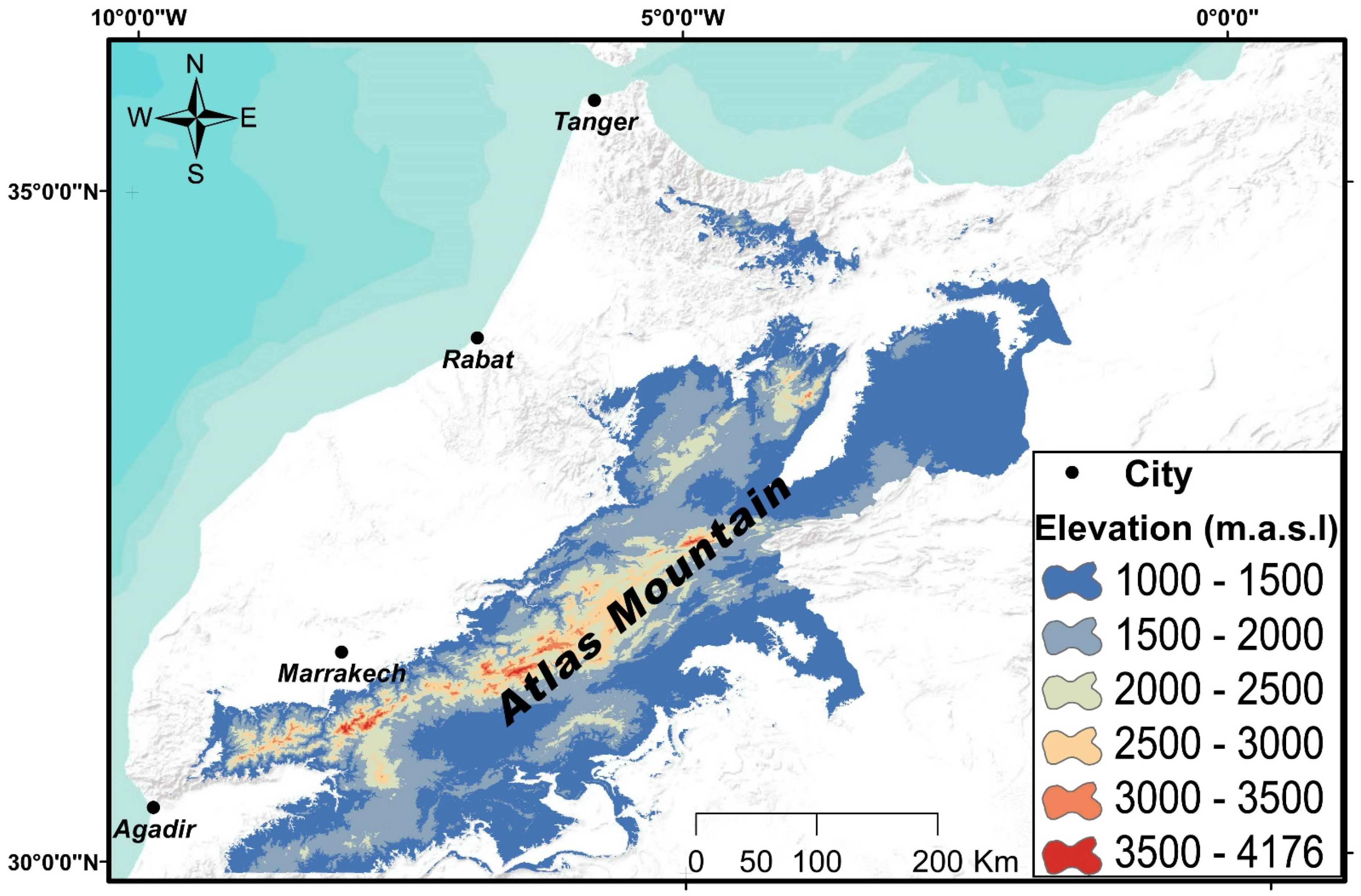
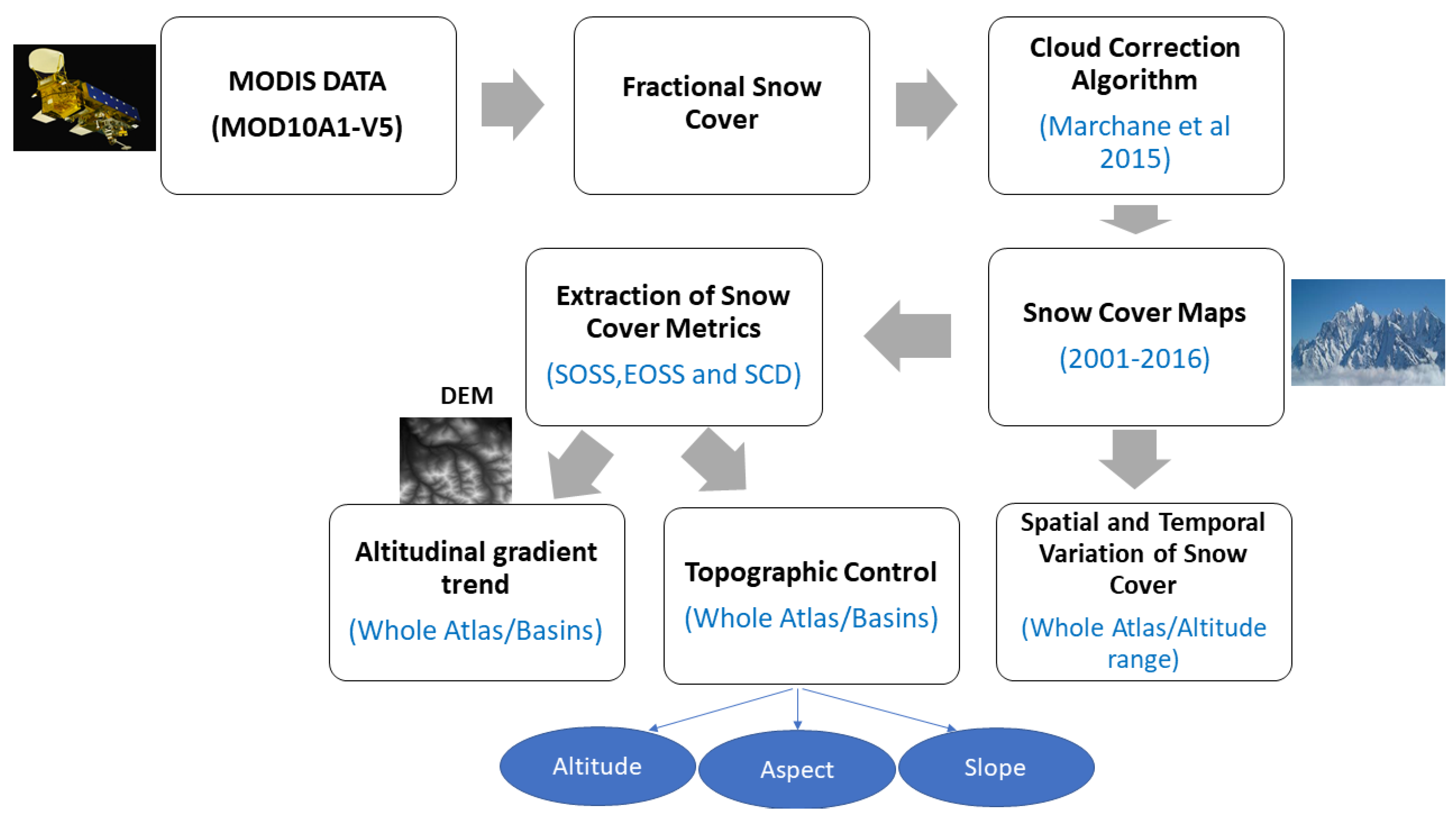



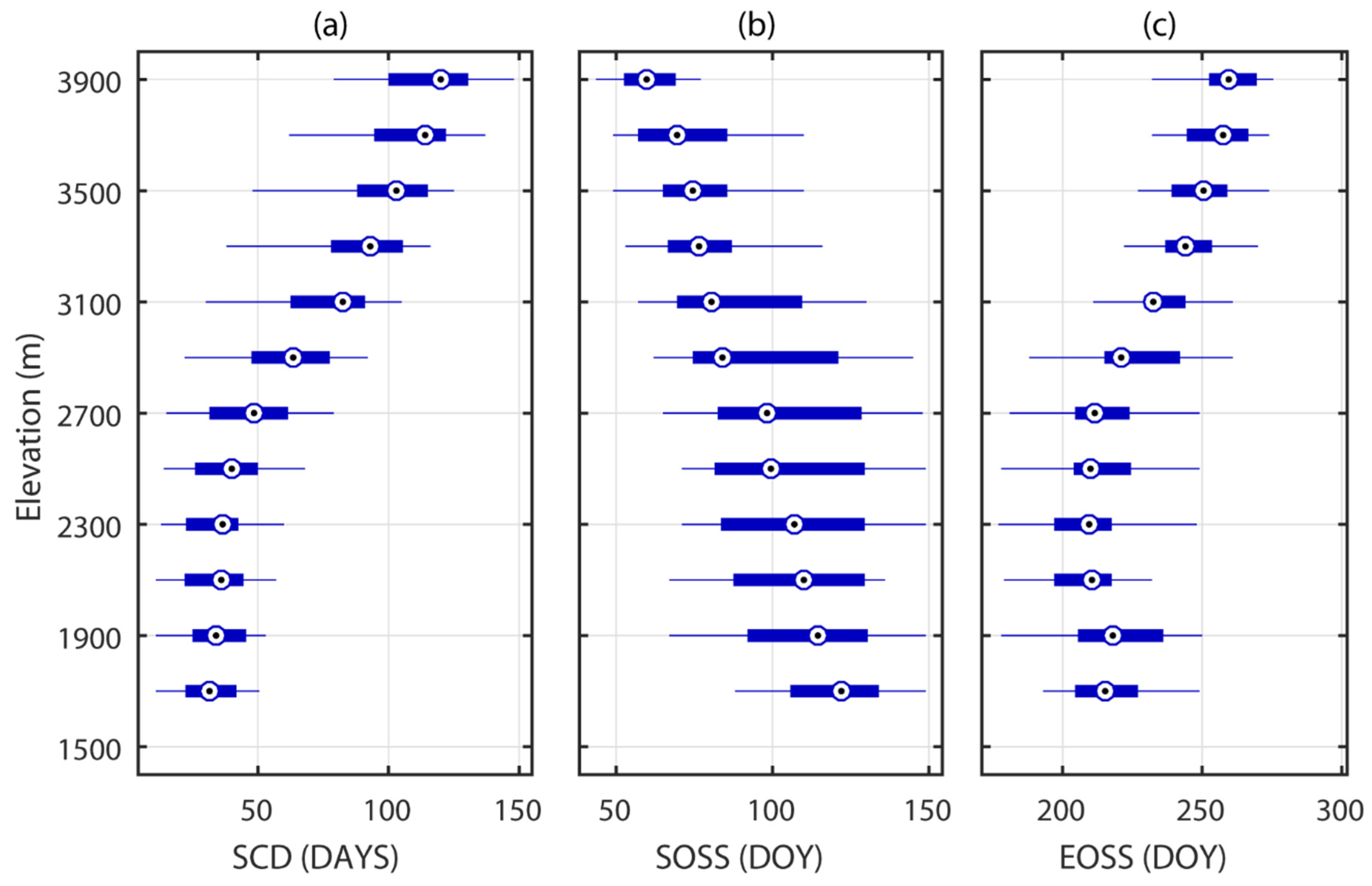

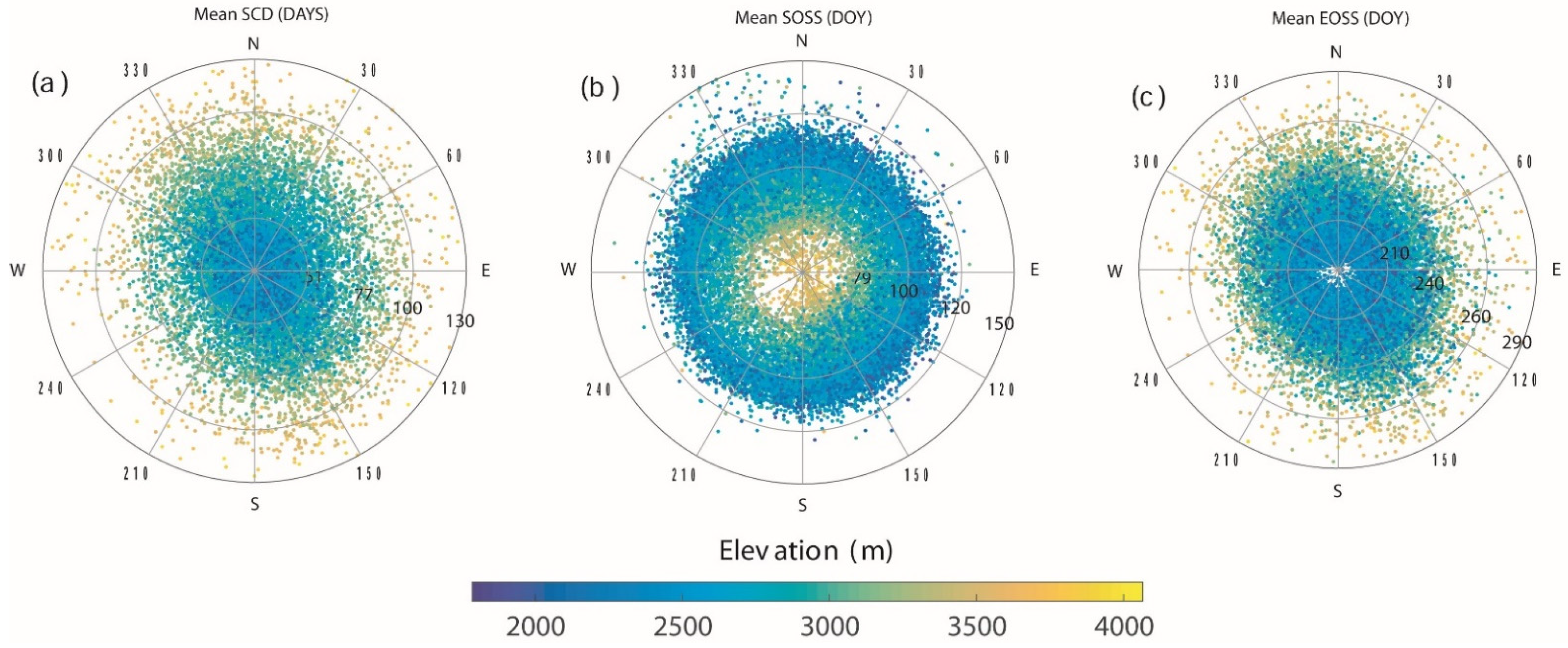
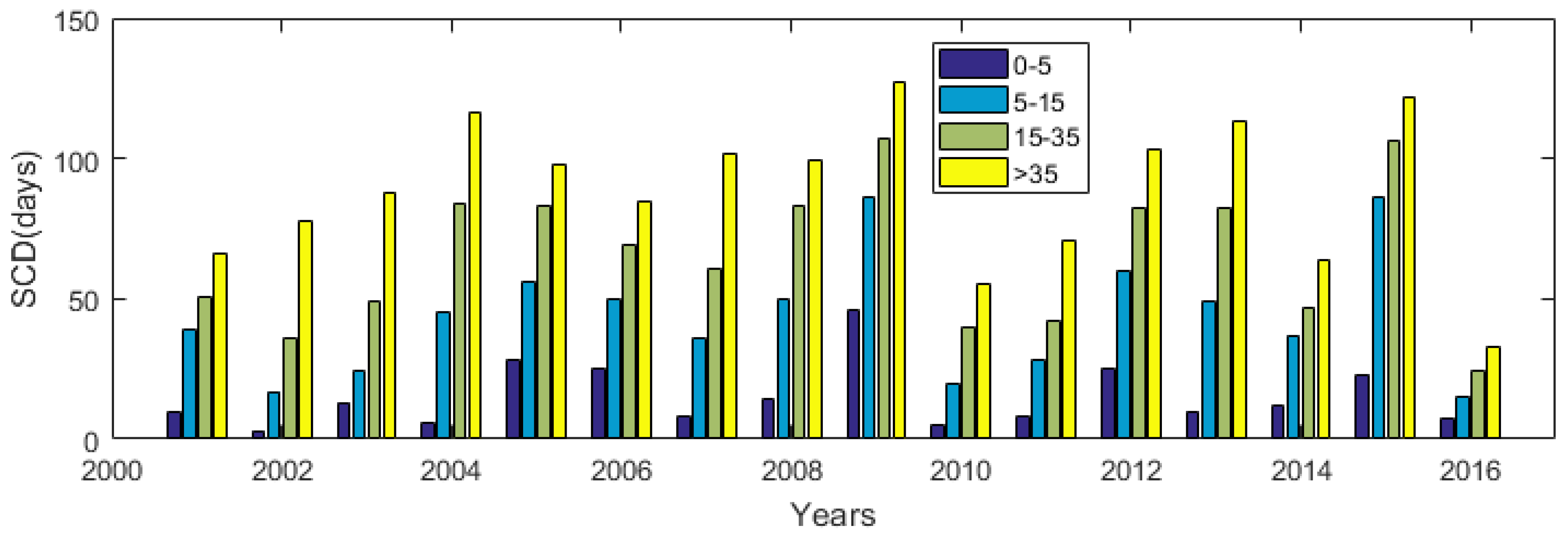


| Elevation Range | Average Elevation (m) | Areal Extent (km2) | Areal Proportion (%) |
|---|---|---|---|
| 1000–1500 | 1231 | 66,028 | 54.6 |
| 1500–2000 | 1713 | 35,464 | 29.3 |
| 2000–2500 | 2213 | 13,128 | 10.8 |
| 2500–3000 | 2701 | 5189 | 4.3 |
| 3000–3500 | 3177 | 1037 | 0.9 |
| 3500–4200 | 3644 | 155 | 0.1 |
| Classification of Orientation | Classification of Slope Gradients | ||||
|---|---|---|---|---|---|
| Aspect | Areal Extent (km) | Areal Proportion (%) | Range of Slope (°) | Areal Extent (km2) | Areal Proportion (%) |
| North-facing | 34,656.2 | 28.6 | 0–5 | 52,509.7 | 43.4 |
| East-facing | 28,193 | 23.3 | 5–15 | 39,816.5 | 32.9 |
| South-facing | 32,783.2 | 27.1 | 15–35 | 24,195.7 | 20.0 |
| West-facing | 25,349 | 20.9 | >35 | 4477.5 | 3.7 |
| Snow Metrics | First Time Periods (2001–2008) | Second Time Periods (2009–2016) | Change |
|---|---|---|---|
| SOSS | −2.38 | −1.93 | 0.46 |
| EOSS | 3.11 | 2.76 | −0.35 |
| SCD | 4.67 | 3.99 | −0.67 |
Publisher’s Note: MDPI stays neutral with regard to jurisdictional claims in published maps and institutional affiliations. |
© 2021 by the authors. Licensee MDPI, Basel, Switzerland. This article is an open access article distributed under the terms and conditions of the Creative Commons Attribution (CC BY) license (https://creativecommons.org/licenses/by/4.0/).
Share and Cite
Marchane, A.; Boudhar, A.; Baba, M.W.; Hanich, L.; Chehbouni, A. Snow Lapse Rate Changes in the Atlas Mountain in Morocco Based on MODIS Time Series during the Period 2000–2016. Remote Sens. 2021, 13, 3370. https://doi.org/10.3390/rs13173370
Marchane A, Boudhar A, Baba MW, Hanich L, Chehbouni A. Snow Lapse Rate Changes in the Atlas Mountain in Morocco Based on MODIS Time Series during the Period 2000–2016. Remote Sensing. 2021; 13(17):3370. https://doi.org/10.3390/rs13173370
Chicago/Turabian StyleMarchane, Ahmed, Abdelghani Boudhar, Mohammed Wassim Baba, Lahoucine Hanich, and Abdelghani Chehbouni. 2021. "Snow Lapse Rate Changes in the Atlas Mountain in Morocco Based on MODIS Time Series during the Period 2000–2016" Remote Sensing 13, no. 17: 3370. https://doi.org/10.3390/rs13173370
APA StyleMarchane, A., Boudhar, A., Baba, M. W., Hanich, L., & Chehbouni, A. (2021). Snow Lapse Rate Changes in the Atlas Mountain in Morocco Based on MODIS Time Series during the Period 2000–2016. Remote Sensing, 13(17), 3370. https://doi.org/10.3390/rs13173370







